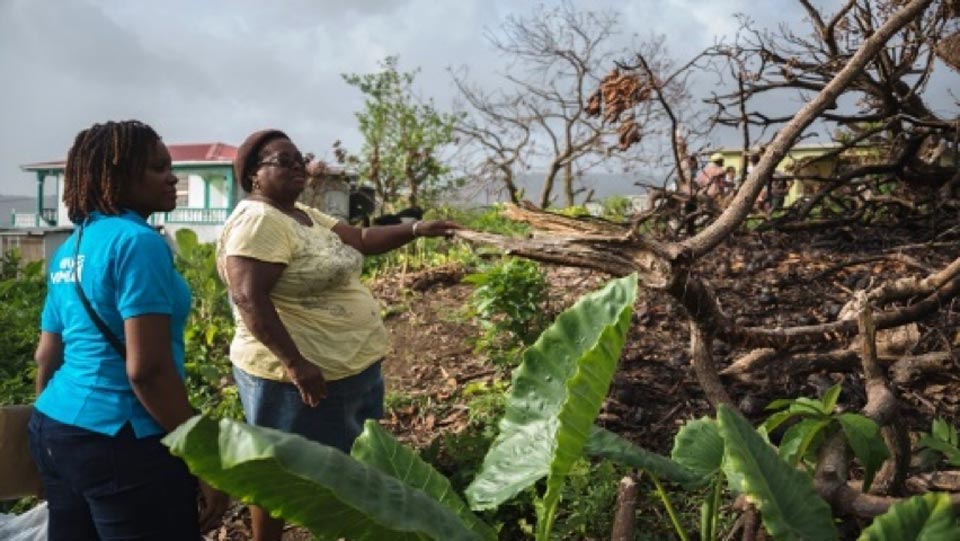Accessibility menu
Content for the offcanvas goes here. You can place just about any Bootstrap component or custom elements here.
The gender and age dimensions of a hurricane in Dominica
Gender and age inequality of disaster risk

Mortality and number of people affected
Hurricane Maria struck Dominica on the 18th September 2017. 65 people were killed, approximately 29 were women, eight were children (3 of whom were girls).
Almost 63,000 people, around 90 percent of the population, were directly affected and had urgent needs (for food, water, electricity, tarpaulins, medication, and building repair materials). This included 19,800 children. As per the last census (2011), women represent 48.9% of the population.
Gender-based violence
There is very little data relating to gender-based violence (GBV) after the hurricane because government records were destroyed and the systems and processes recording and offering support to survivors of GBV collapsed. Reports from before the hurricane indicate that GBV, particularly intimate partner violence and violence against children, is a prominent issue in Dominica, in a context where marital rape, for example, was only criminalised in December 2016. The Department of Social Welfare is severely under-resourced to address issues of GBV even in a non-emergency setting, with just one Child Protection Officer serving the whole country in 2017.
The collapse of formal GBV reporting pathways post hurricane, meant victims of GBV were less likely to report the crime and less likely to receive the support they required. A small survey of 46 women and girls staying in shelters post hurricane found that fear of being identified, and a lack of confidential services, were major factors preventing survivors of GBV from accessing services.
There were also reports of young and teenage girls experiencing sexual harassment, grooming and voyeurism, often when they were left alone or unsupervised in shelters. There were reports that shelter residents were concerned about a lack of privacy and a lack of security in shelter sites.
Unequal impacts on livelihoods
The impacts of Hurricane Maria on livelihoods were gendered; women in Dominica are largely engaged in the informal economy, mostly in subsistence agriculture, which was significantly impacted. Women in Dominica have a lower rate of formal employment (42.2%) compared to men (57.8%), with women more likely to work for no or lower wages.
Women’s reliance on home-based livelihood activities, such as hairdressing and shops, were affected by the significant damage to housing. The indigenous Kalinago community, largely reliant on subsistence farming and tourism for income, was also severely affected by the damage to these sectors.
Agriculture was substantially affected by hurricane Maria, with reports of up to 100 percent damage in some areas. Overall, 79.4 percent of women farmers reported that they had experienced severe damage and loss to their crops and tools.
Damage to road infrastructure negatively affected livelihoods with female farmers reporting being unable to move produce to markets. However, there were also some reports that root crops, a crop mostly planted by women, survived well, contributing to the food security of some families in the immediate aftermath.
On a longer timescale, Dominica’s gender unequal access to land, credit and other productive assets is expected to impede women’s ability to recover after a disaster. Interviewees reported insufficient consideration of the resilience and recovery of female farmers.
Poverty
Pre-Maria, 29 percent of people lived below the poverty line. The number of people in poverty rose to 42.8 percent after the hurricane. Women, and particularly single female headed households, are more likely to be poor, and are likely to have been worse affected by the disaster. Poverty rates are higher for women, and among the poorest there is a high incidence of single female-headed households. 41.6 percent of women participate in the labour market compared with 58.4 percent of men, and 45 percent of people living below the poverty line belong to female-headed households, even though they make up 37 percent of households in the country.
Single women-headed households (who represented 15 percent of displaced households) were more vulnerable both to the immediate impacts of the hurricane and the longer term projected increase in poverty. Single women-headed households in Dominica tend to be larger than other households, with greater caring and maintenance responsibilities and lower levels of income. This can mean they are less able to recover from disasters.
In summary, the case study highlights the ways women and girls were disproportionately impacted Hurricane Maria – particularly in relation to livelihoods – and this is attributed to pre-disaster inequalities in roles, access to resources and assets, and in particular land and credit; with particularly severe impacts for women-headed households.
This case study, was one of three collected as part of a research paper: “The Gender and Age Inequalities of Disaster Risk” – prepared by UN Women and UNICEF